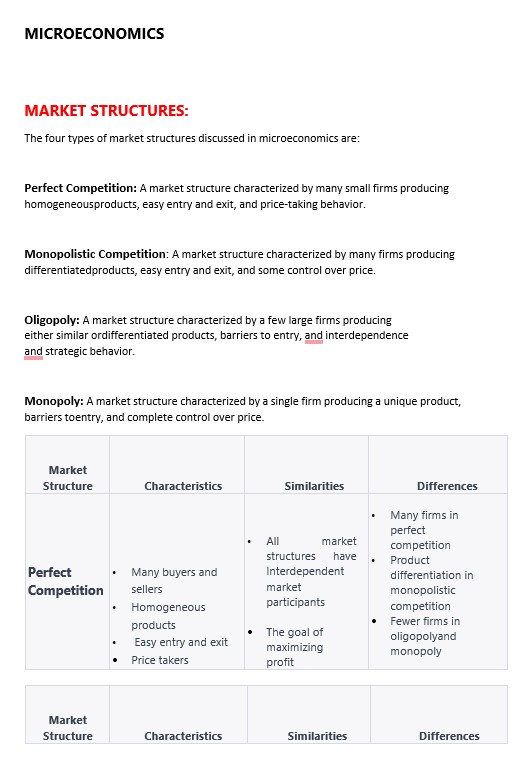Microeconomics
Summary:
Important notes for Market Structure and Associated Terminology in Microeconomics
Excerpt:
MICROECONOMICS – MARKET STRUCTURES:
The four types of market structures discussed in microeconomics are:
Perfect Competition: A market structure characterized by many small firms producing homogeneous products, easy entry and exit, and price-taking behavior.
Monopolistic Competition: A market structure characterized by many firms producing differentiated products, easy entry and exit, and some control over price.
Oligopoly: A market structure characterized by a few large firms producing either similar or differentiated products, barriers to entry, interdependence, and strategic behavior.
Monopoly: A market structure characterized by a single firm producing a unique product, barriers to entry, and complete control over price.
DIFFERENCES BETWEEN SOME MAJOR TERMS:
• Determinants of price elasticity of demand and that of supply: The determinants of price elasticity of demand are the factors that influence the responsiveness of the quantity demanded to changes in price. The determinants of price elasticity of supply are the factors that influence the responsiveness of the quantity supplied to changes in price. The main difference is that the determinants of price elasticity of demand relate to the demand side of the market, while the determinants of price elasticity of supply relating to the supply side.
• Total revenue when demand is price elastic and when it is price inelastic: Total revenue is the total amount of money received by a seller from the sale of a good or service. When demand is price elastic, a small change in price will result in a large change in quantity demanded, and total revenue will change. When demand is price inelastic, a small change in price will result in a small change in quantity demanded, and total revenue will change little. If the price increases, total revenue will increase for price inelastic demand, but decrease for price elastic demand.
• Efficiency and equality: Efficiency refers to the optimal use of resources to produce a given output, with no waste. Equality refers to the distribution of resources, goods, and services among individuals in society.


Reviews